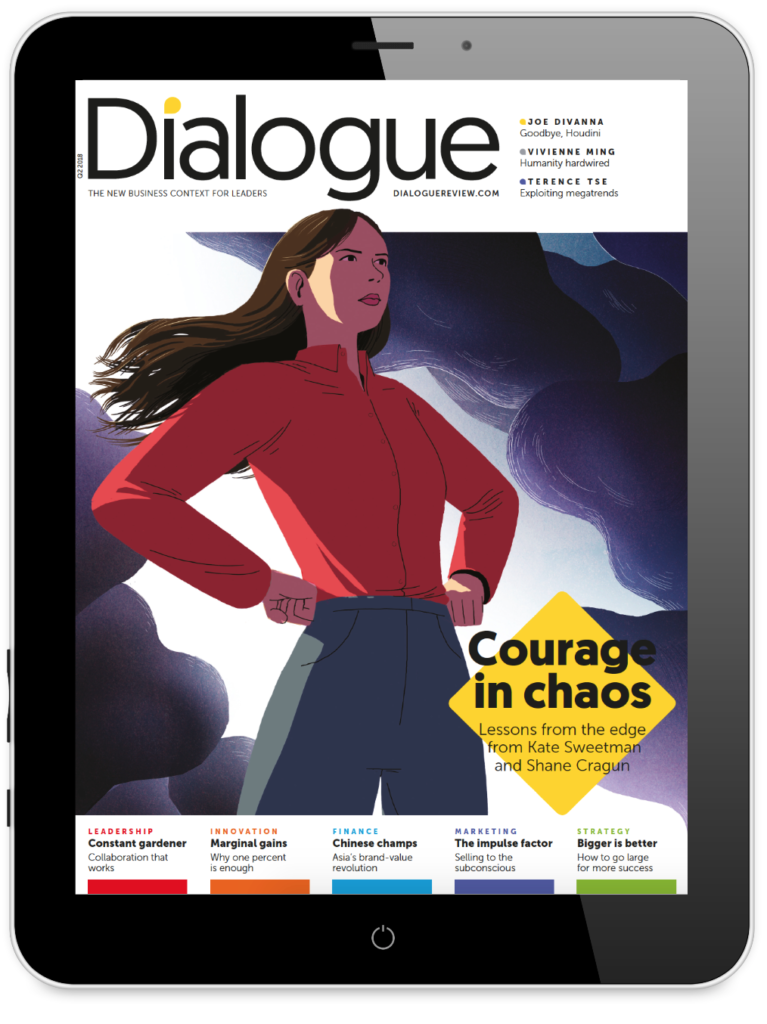Dialogue Q2 2018 is out March 1st. Here is what you can expect, from the desk of Dialogue editor, Ben Walker

He was better known for his singing, but the Brat Pack legend Sammy Davis Jr had it right about fear. “You always have two choices: your commitment versus your fear,” the great performer said. You can be as determined as you like to do a great job, lead well, drive your business forward, but when fear gets in the way, your efforts soon become blunted. Fear is the great barrier in business, as in life – and when the world is as chaotic and volatile as it is now, it breeds readily.
Our Focus topic this issue is the courageous leader. This ought not invoke thoughts of the stale ‘hero leader’ stereotype who roamed the corridors of corporate power in the 1980s, only for analysts to later discover that leadership is a facility that is better distributed than concentrated in one individual (see Kate Cooper, page 33). No, the courageous leader can come from anywhere in the business, but must be prepared to take the risks required, and use the imagination necessary, to succeed in a business landscape where disruption trumps the day-to-day. In our cover story, the brilliant Kate Sweetman and Shane Cragun demonstrate why the leaders we need are those that accept ambiguity, and act with courage, speed, and conviction.
In the same section, Dialogue’s very own Dr Liz Mellon suggests ways to make it easier to be courageous by driving fear – the business killer – out of the system so risks can be taken, imaginations can thrive and, crucially, decisions can be made. Mellon has witnessed more than her fair share of fearfulness in companies. Her memorable anecdote about visiting a client where the chief financial officer had to sign off on bottled water in meetings will resonate with teams who, instead of being empowered, have become hamstrung by an escalation culture that renders most of them impotent.
A great critique on risk-aversion comes from Dialogue stalwart Joe DiVanna, who makes a powerful case that many senior chief executives are leading a Houdini-like existence, forever plotting to make good their escape. By focusing on broadly maintaining the status quo, these non-boat-rockers are failing their brief, argues DiVanna. The job of a business leader is to ready the company for what’s next; not defer, transfer and delay decision-making so they can reach retirement while incurring minimum risk.
One person who personifies the courageous leader is the neuroscientist and entrepreneur Dr Vivienne Ming. Duke Corporate Education chief executive Michael Chavez interviewed her and heard a real-life story of sheer bravery; a journey from nadir to pinnacle. Read it, and quite possibly weep, on page 28.
The neuroscience theme continues in part on page 60, where Gavan Fitzsimons explores unconscious marketing – and reveals some dark, astounding, truths. Read up on why fast-forwarding past TV ads on your PVR might not shield viewers from the power of advertising after all. In fact, the opposite appears true.
A final word should go to the prolific William A Cohen, who, in his entertaining comparison of the great Peter Drucker with Sherlock Holmes, paints a portrait of a man who was prepared to challenge received wisdom (and client preconceptions) to deliver transformative business success. Drucker was famed as a consultant, not a leader, but he was courageous nevertheless. Just like the disruptors of the modern age, the father of modern management found that fortune really does favour the brave. Enjoy the issue.
–– Ben Walker is editor of Dialogue
